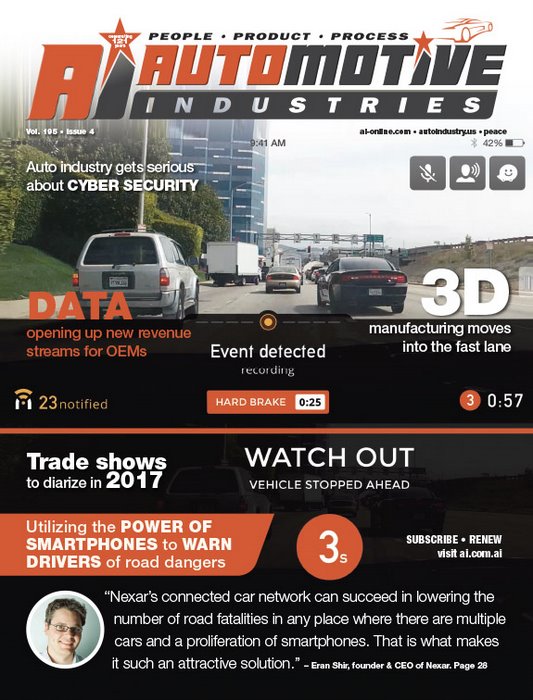
Technology is coming to the rescue of drivers, who are responsible for the majority of fatal road accidents.
According to the World Health Organization some 1.25 million people die each year as a result of road accidents and between 20 and 50 million more are injured. Most of these accidents are due to human error. In the United States alone, some 94% of the over 35,000 vehicular fatalities that occurred in 2015 were the direct result of human error, according to the National Highway Traffic Safety Administration (NHTSA).
“We can’t afford to wait for the advent of autonomous cars to remove human error from the equation,” says Eran Shir, CEO of Tel Aviv / San Francisco – based Nexar. In November, 2016, the company launched the world’s first vehicle-to-vehicle
(V2V) network to detect oncoming dangers and to one hundred car crashes and produced collision reconstruction reports based on phones’ cameras and sensors. At present the bulk of users are in New York City, San Francisco, and Tel Aviv.
Automotive Industries (AI) asked Eran Shir, founder & CEO of Nexar, to explain how smartphones are being used.
Shir: Nexar makes use of your phone’s camera, accelerometer and gyroscope, noting your position in relation to other vehicles. The app applies machine vision via the forward-facing camera to understand when a dangerous situation is brewing and gives drivers immediate “watch out!” warnings that will prevent needless crashes caused by simple distraction, inattentiveness, and human error.
The next level of Nexar’s technology is vehicle-to-vehicle alerts. This is part of the autonomous vehicle future which is heavily endorsed by the American Department of Transportation and NHTSA. The basis of V2V networking is that cars report to each other the speed, location, and trajectory of nearby vehicles to avoid collision paths. In order to accurately report on what is happening in a particular location Nexar uses sensor fusion algorithms to get the position right at lane resolution 50 times a second. A GPS in contrast works on a one second update rate and 25 feet average accuracy.
AI: How do you see Nexar’s technology cutting road accidents?
Shir: Nexar’s forward-collision warning system can alert distracted drivers about oncoming dangers, cautioning them in advance so they can take precautionary steps to avoid a collision. For example, when a car stops abruptly ahead, the drivers of vehicles behind are given immediate warnings, and have those few precious seconds to stop. At a mass-market level, Nexar becomes a real-time network that can warn drivers about cars that are out of their line of sight.
AI: What have been some of the challenges facing Nexar and how have you managed to overcome these challenges?
Shir: Developing AI technology is already quite challenging, but for Nexar a big challenge is to jam as much of that technology as possible into smartphones. These phones are getting better every year, but we are pushing the envelope by putting so much powerful software into these readily available devices.
Nexar is very powerful as a standalone app, but its largest value will show when it creates a dense enough network. Acquiring a dense enough user-base in local areas is challenging and that’s why we decided to focus on two high-density urban metropolises: New York and San Francisco. We require only a 1%-4% adoption rate within a city to create an effective network, and that is our challenge that we’re in the process of overcoming now.
AI: Who are the big players in this market and how has your company gotten a head-start in the V2V ecosphere?
Shir: Nexar is deploying the first viable V2V network. Our over-the-top approach using smartphones to build a vehicle-to-vehicle network is unique. Auto manufacturers, specifically autonomous vehicle manufacturers, may be working on developing V2V capabilities, but we are ahead of the curve in that category.
AI: How will V2V networks grow in the future according to your predictions?
Shir: Right now, the bulk of early adopters of V2V networks are professional drivers, because targeting fleets is the easiest way to hit the 1-4% penetration needed for the network to be effective and their average mileage per vehicle is typically high. However, we’re already seeing a lot of interest from the average consumer, both because of interst in increasing road safety, and also due to the dashcam culture that is becoming commonplace in the ride-sharing industry. The added safety and liability protection that Nexar offers makes an enormous difference and will allow insurance companies to more effectively reward good drivers by reducing their premiums.
AI: Tell us a little about Nexar, the company.
Shir: Our goal at Nexar is very simple—eliminate car collisions on the road. To get there, we’ve created a free, AI-backed dashcam app that can give any vehicle the benefits of hi-tech safety features, such as machine-vision-based warnings of sudden brakes ahead on the road. Our latest step toward achieving our goal is the launch of our V2V network, which will create a comprehensive network of all the vehicles driving on the roads. This will create a communicative community of cars that will share their data to enhance road safety and reduce collisions. The more our network scales, the more effective it will be.
AI: Will it work in countries like India, where road fatalities are among the highest in the world?
Nexar’s connected car network can succeed in lowering the number of road fatalities in any place where there are multiple cars and a proliferation of smartphones. That is what makes it such an attractive solution. You don’t need a car outfitted with expensive hardware, just your phone. India, for example, is ripe for penetration by our Nexar network. The country is infamous for the high density of cars on the roads, and nearly 30% of the population uses a smartphone. Nexar only requires 1% of the population to be active Nexar users in order for the network to function accurately, so countries like India could certainly benefit from Nexar’s technology.





More Stories
Baja SAE Carolina:
ROHM to Showcase Advanced Power Electronics at APEC 2025
ROHM Launches 650V GaN HEMT in a Compact, High-heat Dissipation TO-Leadless Package